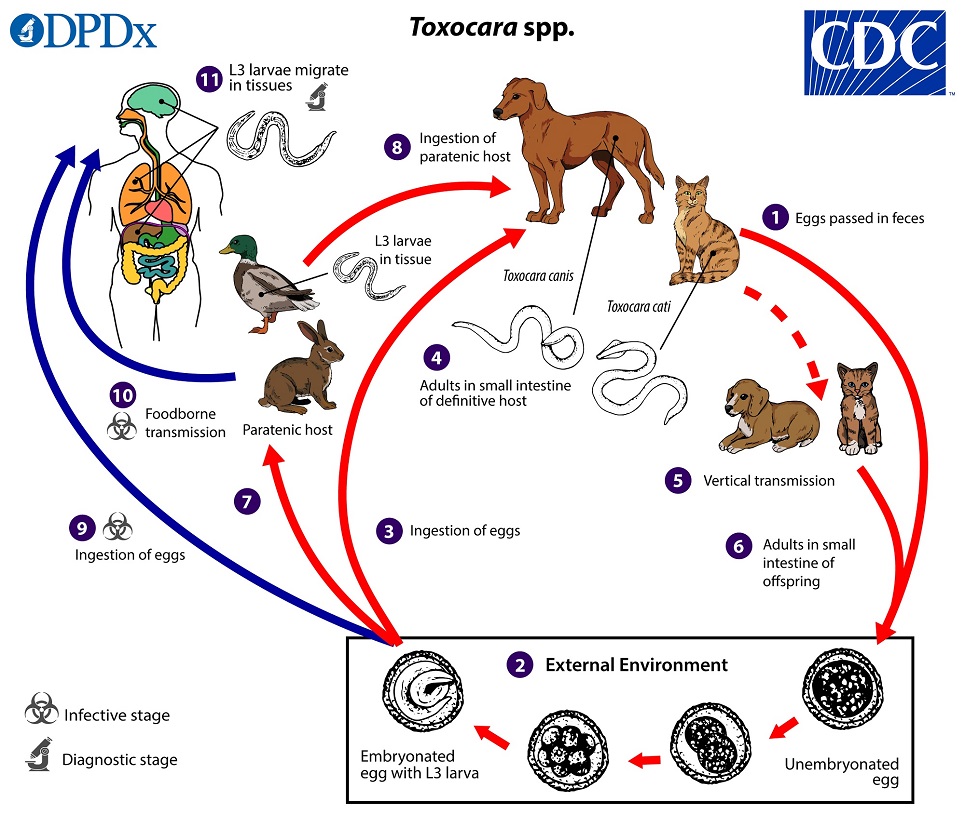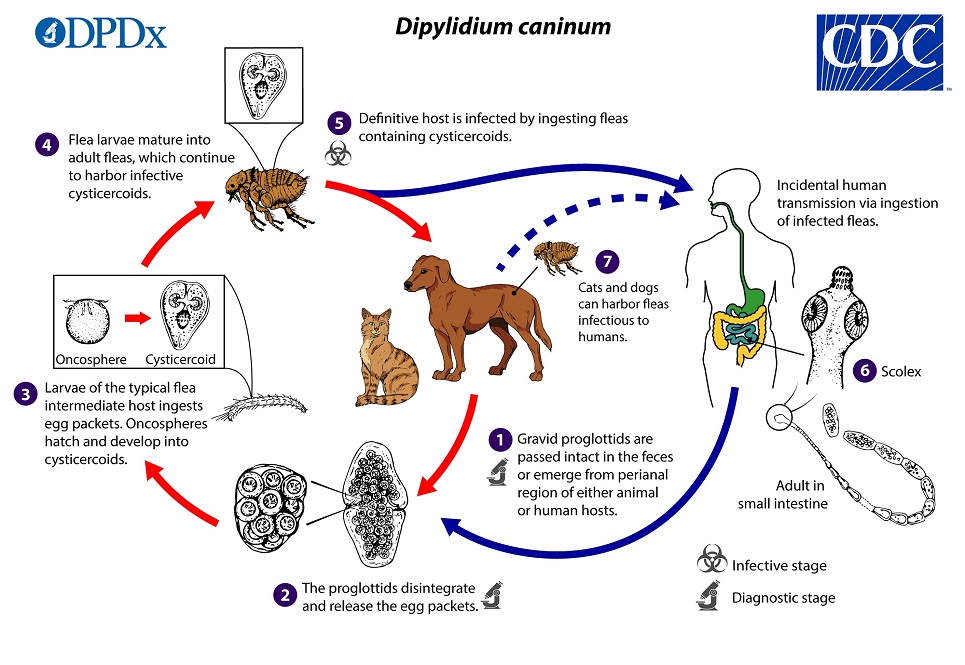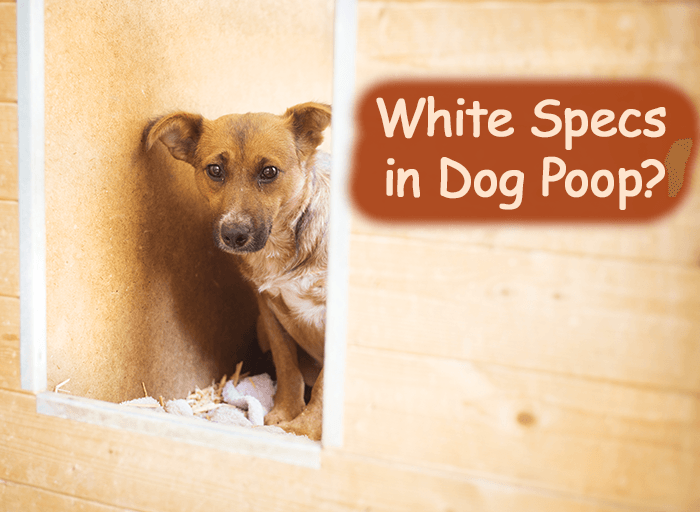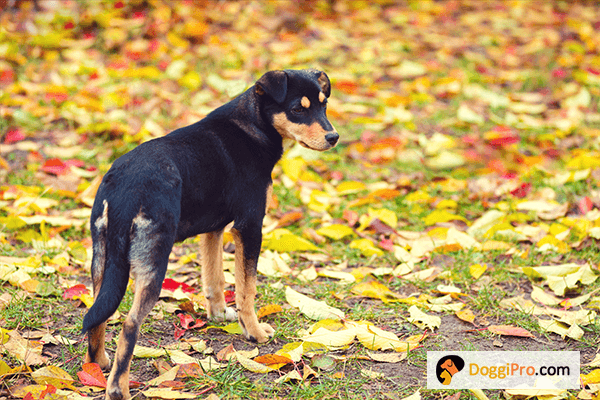When you’ve been taking care of your dog’s poop for a while, you start learning what’s normal. The presence of something you don’t normally see might cause some concern. Like, when you see white specks on your dog’s poop. I got concerned when I saw these one time, so I just had to research to ensure my dog was alright.
What are the white specks in dog poop that are not moving? These are undigested food remnants, for example, traces of bone or rice. Most of the time, a white spec that is not moving is a small bone or cartilage that the dog consumed in their last meal.
You may not know your dog has some cartilage or bone diseases until they cause blockage. If you are not sure and have access to a veterinarian, you should have them look. They may do some testing to see what it is.
What are the white specks in my dog poop that is not moving?
Carefully observe your dog’s fecal matter to identify it. The white specks that are not moving may be small pieces of bone and cartilage from the meal they just ate or evidence of a parasite.
If you notice that the white specs are not moving, you may have to get a closer look to determine what it is.
Picking up the stool and getting a closer look may not be the most pleasant thing to do, but it is worth checking to see what it is. You do not want to feed your dog an intestinal parasite or a piece of bone that may cause blockage in your dog’s intestines.
Why does my dog have a white thing in his poop?
If your dog is not eating many bones or raw meat, then there are some other reasons why you may notice white stool. It’s normal for a dog’s poop to be white, especially if they eat a lot of bones or raw meat. There may also be white foam in the poop. This white substance is because the dog’s intestines break down fats and proteins from meat and bones. When these substances reach the stomach, they are mixed with water and pancreatic enzymes to form a substance known as chyme. Chyme is very acidic and will appear white or creamy white.
White Fatty Stool
Pancreatic disease is rare in dogs, but it can cause digestive issues, including an inability to digest fats. Excessive eating of fatty foods may cause white stool. A white stool can be a problem for dogs with pancreatic or liver conditions. If your dog is vomiting or having diarrhea, you should immediately take your dog to the vet.
White Milk Stool
Dogs that have lactose intolerance may have diarrhea or white stool. Sometimes it’s just a change in food or a change in diet, and other times it’s a problem with the dog’s body and how it handles sugars and dairy products. If you see white or yellowish poop and your dog has digestive issues, you should see a vet.
What Causes White Specks In Dog Poop?
White specks can have a variety of causes, including harmless ones like hair and eggshells, but they can also indicate the presence of a parasite or worm.
Gastrointestinal worms are a common cause of digestive problems, not just in dogs but also in humans.
When they’re in your dog’s digestive tract, they can irritate, leading to these white granules.
It’s important to know this, so you can start treating the problem right away.
Symptoms of intestinal worms in dogs include frequent visits to the bathroom and stomach aches, vomiting, diarrhea, and weight loss.
Treating your dog with a dewormer, will eliminate the worm infestation and quickly help your dog get back to good health.
Another cause of these specks is the presence of hair. Your dog may ingest hair in the environment (such as your own or that of a family member), or they may ingest hair while grooming themselves.
As with worms, it’s important to take action quickly because hair can also signify a deeper health problem.
How to treat white specks in dog poop
If you’re seeing white specks, it’s important to take action right away. If you see a large number of them, contact your vet right away. They may want to perform some tests to ensure they don’t need to treat an intestinal problem in your dog.
If the situation is accompanied by other symptoms, like vomiting, diarrhea, or a lack of appetite, the problem may not be harmless, and you should contact your vet immediately.
However, if you see a few small substance here and there, it’s usually nothing to worry about. It’s just something you’ll have to watch out for as your dog eats and drinks throughout the day.
If you’re not sure, you can always ask your vet to do a fecal exam. The vet can conduct a simple test that will allow them to identify any weird things present in your dog’s poop.
If your dog has an intestinal worm infestation, your vet will give them a dewormer to kill the worms.
If there’s hair present, your vet will recommend a de-hairing treatment to help remove any additional hair that may be in your dog’s stomach.
White specks in dog poop, while they can be annoying, are generally not a cause for concern. It’s important to keep an eye on your dog’s health, so if you see white specks on their poop, you’ll know what to do.

Some Common Causes for White Specks in Your Dog’s Poop:
1. Paper pieces
White specks in dog poop can also be paper pieces that your dog has chewed up.
2. Cement chunks
Cement chunks that your dog may have eaten can cause white specks.
3. Traces of bone
If your dog has eaten bones, these may also appear as tiny flecks in your dog’s poop.
4. Just the remains of a dog treat
It is also possible that these can simply be the remains of a dog treat that the dog has recently eaten.
5. Improperly digested medication
Dog poop may also have white specks if you have recently given your dog medication. In this case, it would be the remains of the pill or capsule that hasn’t digested properly.
6. Improperly chewed food
Food that your dog has swallowed too quickly can also cause white specks. If your dog is eating food fast, this can cause swallowing large chunks of food that need proper chewing.
7. Food allergies
Food Allergies can also be a possibility, especially if the white specks appear to be moving.
8. Sometimes just a result of aging
If your dog is older, it is also possible that white specks in dog poop could be just a sign of normal aging and nothing to worry about. Especially true if you are feeding your dog a normal diet that doesn’t include food intended for humans.
9. Sometimes just dirt
If you have been letting your dog outside regularly to relieve himself, the white dots may simply be traces of dirt.
10. Parvovirus
Another possibility is that your dog has the Parvovirus. Parvovirus is a viral disease that causes bloody diarrhea and, in some cases, the passage of white specks.
11. White blood cells
Very occasionally, the tiny white dots in dog poop might be white blood cells. These are often only observed in extreme circumstances, such as if your dog has an infection.
12. Coccidia
Coccidia can also be possible, especially if the white specks appear to be moving. This disease occurs in your dog’s small intestine and causes irritation and inflammation.
13. Cancer
In the very rare circumstance that your dog’s tiny white specks are moving, they may be cancer cells. Cancer is very unlikely, but it is a possibility.
The good news is that none of these are likely to be a serious health concern. Your dog may have some irritation if your dog is reacting to the food, but this is typically not the case.
Hopefully, this list will help you figure out the white dots in your dog’s poop. If you are still unsure, you should take a sample of the poop to your vet for them to analyze.
What kind of foods can cause white poop?
A dog’s digestive system can not handle certain foods so that some foods can cause white poop.
Anything which contains a great deal of fiber can cause white poop. Dogs do not have the digestive enzymes to break down fiber. Celery, broccoli, and green beans are all foods that can cause white poop due to the fiber content.
Food allergies can also cause white dog poop. Pets can have allergies just like people. If a dog eats something to which it is allergic, it can develop diarrhea or white poop. Vomiting usually accompanies food allergies. If a dog is suffering from white poop and vomiting, something is seriously wrong. The dog needs to see a vet as soon as possible.
Is white dog poop dangerous?
Poop is poop. Brown or white, it’s all the same. White poop is simply the result of a dog’s digestive system being unable to digest a substance correctly.
The white stuff means something wrong with the animal’s diet or its digestive system. Some substances can’t be digested and must pass through the dog’s system. It’s not dangerous if you’re talking about a healthy dog. The dog’s diet is the most important factor. If a dog is eating an inappropriate diet, white poop is a warning sign.
Depending on the substance and the type of food the dog is eating, white poop can be dangerous.
Dogs are carnivores, which means that they eat meat. If a dog’s diet lacks protein, white poop is one of the first warning signs that something isn’t right. White poop can also be caused by consuming an overabundance of fruit and vegetables.
Why would this be dangerous?
Because it’s not what they eat.
A dog’s digestive system digests the foods which the wild canines in the forests of North America eat. The dog’s digestive system has evolved to digest raw meat, if you think about it.
Do you think that a dog’s digestive system can digest poached fish? Of course not.
The consumption of an inappropriate diet can also cause white poop due to bacterial infestation in the dog’s digestive system.
Should White Specks Be Cause For Concern?
White specks in dog poop are not a cause for concern. It’s usually just because the dog ate white bread or fruit. These fruits or pieces of bread turn into white pieces of poop, which is visible when observing the dog’s stool.
The white specks will usually have to do with what they have eaten recently – likely white bread or fruit. White specks are the fecal remnants of the dog’s digestive system. The color of these feces may vary depending on what the dog has eaten. Usually, they are white or yellowish.
It is important to note that these feces don’t always digest completely, leading to uncomfortable conditions for both animals and humans. Apart from this, it also exposes your dog to various infections and diseases, including Toxoplasmosis, Hepatitis A virus, Salmonella, Yersinia Enterocolitica, etc.
White specks can also be due to vitamin B12 deficiency. Supplement these vitamins through a healthy diet and multivitamins.
White specs can also identify the presence of parasites like tapeworms, pinworms, and whipworms in dog poop.
What should I do if I notice white specks in my dog’s poop?
The best thing to do is simply avoid giving your dog any more of the food he has recently eaten. Avoid giving him any dog treats and avoid giving him any medication.
If you want to check with your vet, this is a good idea. They will tell you whether or not there is anything that you need to be concerned about. They may want to examine your dog to see if there is any way to determine what the cause is.
One thing to remember is that this is typically not something that will be harmful. It may cause some irritation to your dog’s digestive system, but this is not always the case.
So what is the best thing to do when you find white specks in your dog’s poop?
There are several reasons why you might notice these white specks. These include the causes mentioned above.
If you notice these, you will probably not have to do anything because they do not usually mean something that will cause a serious health problem.
However, if you notice any other signs that indicate that something might be wrong, you should have your dog checked out by a vet. These may include things like:
- Vomiting
- Blood in the dog’s poop
- Trouble defecating
- Straining to defecate
These can be signs of a serious health problem.
If you notice these signs, you should have your dog examined by a vet. They will tell you whether or not there is anything that you need to be concerned about.
Most of the time, you can relax. There is no reason to panic or overreact. Because most likely, it’s just an innocent occurrence and a minor health concern.
However, the white specks can signify a more serious health problem in some cases. If you notice this, you should have your dog examined by a vet as soon as possible.
The white speck is moving
What if the white speck is moving? Then it is probably a parasite or a worm. You need to call your vet to get some advice on what you need to do. If you are unsure and want to be safe, it is best to invest in a fecal test kit. There is no sense in feeding your dog something that you do not know what it is. If you are not sure, take a look and make sure. You do not want to risk your dog’s health. Take the appropriate action to ensure they eat what you think they are eating.
How do dogs get worms?
The most common way dogs get worms is by eating the eggs or larvae of these worms passed in the feces of other infected animals. People can also give worms to their dogs by not washing their hands after changing their cat’s litter box or picking up their pet’s stool. If you think your dog may have worms, bring him to your veterinarian for testing and treatment.
How are worms spread?
A dog can get worms from contact with an infected dog, bird, or insect. The eggs of some worms are so small that they can travel in the air, soil, or water and get into a dog’s body.
Another way that dogs can get worms is from eating a worm-infested rodent or from eating an animal that worms killed.
A dog can also get worms from eating grass, worms, or dirt.
What are the signs of worms?
Some dogs don’t show any signs of worms, and owners may not know that their dog has worms. Other dogs may have vomiting, diarrhea, weight loss, anemia, coughing, scratching, and weakness. Some worms may also cause tapeworms in dogs and puppies.
Puppies are more likely to get worms because their immune systems are weaker than adult dogs.
What are the symptoms of worms?
Most dogs that have worms will have no symptoms at all.
If your pet does have symptoms, they may include:
- Diarrhea, which may or may not contain blood
- Abdominal pain
- Weight loss
- Lethargy
- Loss of appetite
- Vomiting
How are worms diagnosed?
The only way to definitively diagnose worms is to take a stool sample and examine it under a microscope. Usually, an experienced veterinarian can identify the type of worm just by looking at the stool sample. However, it’s also useful to know that there are many different parasites whose appearances can be quite similar.
You can find the most common worms infecting dogs below.
If your veterinarian doesn’t recognize the sample, a fecal float test may be required. This test involves adding a few drops of your pet’s stool to a liquid solution that contains special chemicals that allow eggs to float to the top of the water. Vets will then examine the eggs under a microscope.
How are worms treated?
The treatment of choice for worms is a dewormer. There are several different kinds of dewormers, and your veterinarian will choose the one that is right for your pet. Some dewormers need to be given to your pet monthly, while others once or twice a year. Dewormers work by killing the worms, so they need to be administered for several days after the worms have disappeared from the stool. Most dewormers are effective against a wide range of worms, so if your pet has more than one type of worm, you may need to give more than one type of dewormer.
Although not recommended for most pets, you can also treat your pet for worms at home. Some over-the-counter worm medications (like fenbendazole) are safe for most pets, but you should always ask your veterinarian first. The easiest way to treat your pet at home is to purchase a worming capsule from your veterinarian and feed it to your pet. Make sure to follow the instructions on the package. You can also buy a dewormer online and deliver it to your home. The problem with this approach is that it’s hard to tell if your pet is infected with worms since there are often no symptoms. If you do decide to treat your pet for worms at home, you should do so only if your pet is seriously ill and if you are very familiar with the symptoms.
Deworming medication can kill some types of worms. However, some worms require multiple deworming medications or a worming medication that works on the blood (a heartworm medication).
Does my dog need to be treated?
Most veterinarians recommend deworming dogs at least once a year. The exception is if your dog has constant exposure to an area where dogs with worms live. Then more frequent deworming is needed.
If your dog shows signs of worms, your veterinarian will perform a fecal examination to determine whether your dog has worms. Your veterinarian will also recommend deworming your dog, depending on the type of worms. Worms can also be present in a dog’s stool for a long time without the dog showing any signs of worms.
A list of Common Dog Worms and how they are acquired:
Roundworms (Toxocara Canis): Infection comes through contact with the feces of an infected dog or from ingesting an infected flea. A common scenario is a family dog that goes outside to defecate and has fleas. It’s important to remember that the dog must ingest several larvae to become infected. Roundworm larvae infect the fleas. The dog eats the fleas, and the larvae travel through the dog’s body, infecting the dog’s liver and lungs. The dog can become symptomatic for roundworms (e.g., coughing, lethargy, vomiting, etc.). Dogs can also be born with roundworms.

Photo Credit to CDC.gov
Hookworms (Ancylostoma Caninum): Infection comes through contact with the feces of an infected dog. A fecal test will determine if a dog has hookworms. The infection can be mild to severe. Signs can include diarrhea, vomiting, weight loss, weakness, and loss of appetite.
Whipworms (Trichuris Vulpis): Infection comes through contact with the feces of an infected dog. Signs can include: diarrhea, blood in stool, weight loss, vomiting, and a fecal test will determine if a dog has whipworms.
Tapeworms (Dipylidium Caninum): Infection comes through ingestion of the flea. Look for the flea’s movements. If a flea is wriggling and moving, it’s probably infected with a tapeworm. A flea that has an adult tapeworm is much easier to see than a flea that has a tapeworm egg. Signs can include diarrhea, weight loss, lethargy, and vomiting.

Photo Credit to CDC.gov
The most common of these would be tapeworms
How do I tell if my dog has tapeworms?
A good indication that your dog has tapeworms is to look for fleas on your dog. Tapeworms like to live inside of fleas. Also, if you happen to see rice-like white segmented worms on your dog’s bottom, then they may have tapeworms.
What are the symptoms of tapeworms in dogs?
Although dogs do not normally show symptoms when they have tapeworms, they can be problematic when they do occur. The most common sign of tapeworms in dogs is weight loss. If your dog has tapeworms, it may have a sudden drop in weight. Other symptoms include; diarrhea, vomiting, weakness, seizures, and itching. If you notice any of these symptoms, please call your vet immediately.
How do you treat tapeworms in dogs?
It is easy to treat tapeworms. If your dog does happen to get tapeworms, then your vet will prescribe a dewormer to kill the tapeworms. There are also home remedies that you can use if your dog has tapeworms.
Preventing tapeworms in dogs
Flea and Tick Control
The best way to prevent tapeworms in dogs is to use flea and tick control year-round. Use a topical flea and tick medication to do this.
Feed your dog high-quality dog food.
Make sure that you are feeding your dog high-quality dog food. The ingredients in your dog’s food can affect your dog’s health. High-quality dog food will ensure that your dog has all the nutrients needed to be healthy.
Use a shampoo that gets rid of fleas.
If you have an area of your yard that is hard to keep free of fleas, you may need to use a special flea shampoo. Some of the fleas will be hiding in the grass and the dirt. The shampoo will help eliminate any fleas in the grass and dirt. You will need to make sure that you use the shampoo every two weeks to remove the fleas. If you don’t want to use shampoo, you can always use a vacuum to suck up the fleas. Fleas are very tiny and are easy to suck up with a vacuum.
If you find that your dog has tapeworms, your vet will tell you that you need to eliminate all of the fleas you have. You may need to pick up a few fleas from your dog and then put them in a jar.
Be careful when you walk your dog.
Make sure that you check your dog’s bottom after taking your dog out for a walk. It is very important to check your dog’s tail after taking it out for a walk.
Keep your dog’s living area clean.
Make sure to keep your dog’s living space clean all of the time. If you keep your dog’s living area clean, then there will be no place for fleas to live. The fleas will not survive in a cleanroom.
Keep your dog’s bedding clean.
Fleas and ticks love to hide in the bedding and the grass. If you keep your dog’s bedding clean, then you will be able to prevent fleas and ticks from living. If your dog has tapeworms, you will need to eliminate all fleas and ticks.
Keep your dog on heartworm prevention.
Heartworms and tapeworms are two very different things. A parasite causes heartworms, and a parasite causes tapeworms. Heartworm prevention is the best way to prevent tapeworms in dogs.
Checking your dog’s poop for tiny white specks or dots.
Why poop is your friend.
There are two important reasons to check your dog’s poop. Firstly, it can be a window into your dog’s health. Secondly, you may be able to change your dog’s diet and prevent future hairballs in the process.
You’re not alone.
One of the most common problems I hear about from our customers is a hairball or two that have made their way out in the yard. I’ll share some of the most important things you need to know about your dog’s poop in this article.
Why Check Your Dog’s Poop?
If you ever want to know anything about your dog’s health, then you should be checking your dog’s poop.
Dogs are not people, and even though we share the same dietary needs, there are many things in a human diet that dogs should never eat.
When you check your dog’s poop, you can look for key differences in your dog’s poop, and this can give you some great information about your dog’s health.
The biggest reason that many people have never checked their dog’s poop is that it’s so unpleasant. It’s one of those things that we don’t want to do, but it’s so important to our dogs’ health.
Even if you don’t have a hairball problem, you can learn a lot about your dog’s health by checking their poop.
If you want to learn more about checking your dog’s poop, I recommend that you check out this post about What is Normal Poop.
Conclusion
In short, you have a lot of control over what goes into your dog’s mouth. Make sure to read the ingredients in every treat you give to your dog and avoid foods containing additives like colors and flavorings. Use safe treats at all times, and avoid those too hard for your dog’s teeth and gums.
Do your research and talk to your veterinarian before starting a diet that contains mostly treats. Your dog’s diet is important to his overall health, and as an owner, you have a lot of control over what makes it into your dog’s mouth.
This article is accurate and true to the best of the author’s knowledge. It is not meant to substitute for diagnosis, prognosis, treatment, prescription, or formal and individualized advice from a veterinary medical professional. Animals exhibiting signs and symptoms of distress should be seen by a veterinarian immediately.
Sources
“Toxocariasis,” CDC.gov, Page last reviewed: July 9, 2019. Last Accessed January 1. 2022
“Trichuris Vulpis,” CAPCVet.org. Last Accessed: January 1, 2022
“Dipylidium Caninum,” CDC.gov, Page last reviewed: July 10, 2019, Last Accessed: January 1, 2022
- Why Shih Tzu Are The Worst Dog: An In Depth Analysis - February 7, 2024
- Why Schnauzers Are The Worst Dogs (or Are They?) - February 7, 2024
- Can dogs eat gushers? The Answer Might Suprise You - January 26, 2024

